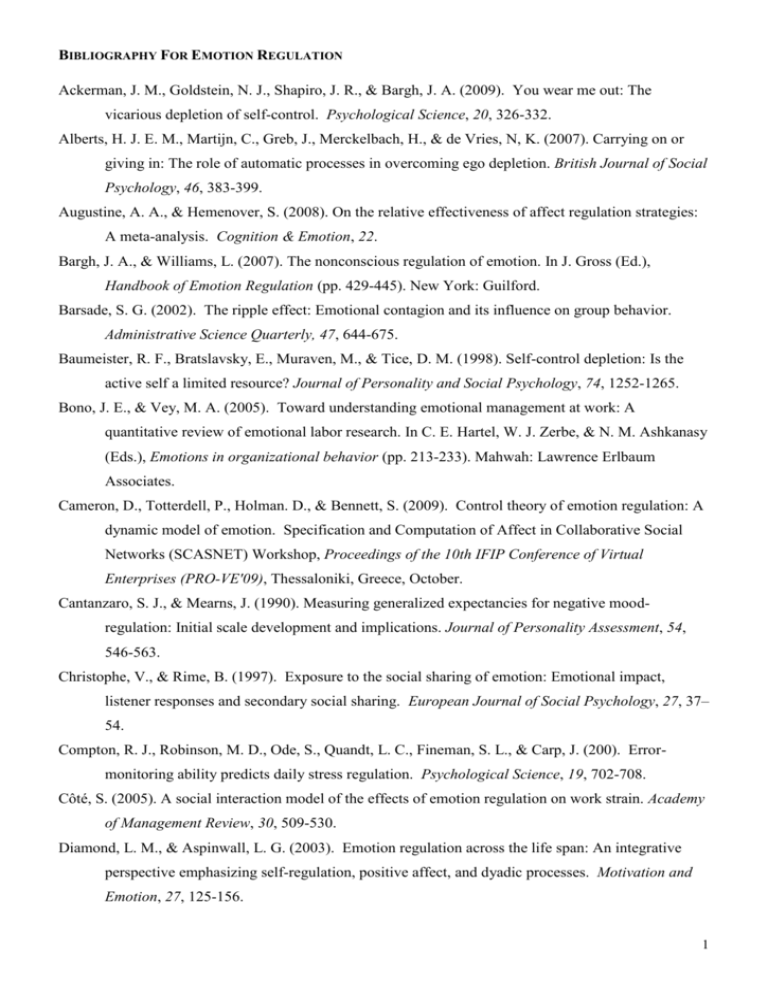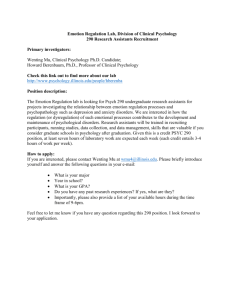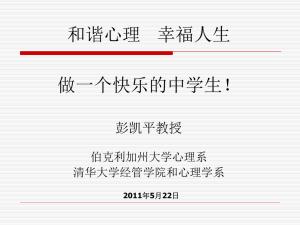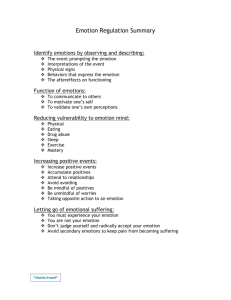Bibliography - EROS Research Group
advertisement

BIBLIOGRAPHY FOR EMOTION REGULATION Ackerman, J. M., Goldstein, N. J., Shapiro, J. R., & Bargh, J. A. (2009). You wear me out: The vicarious depletion of self-control. Psychological Science, 20, 326-332. Alberts, H. J. E. M., Martijn, C., Greb, J., Merckelbach, H., & de Vries, N, K. (2007). Carrying on or giving in: The role of automatic processes in overcoming ego depletion. British Journal of Social Psychology, 46, 383-399. Augustine, A. A., & Hemenover, S. (2008). On the relative effectiveness of affect regulation strategies: A meta-analysis. Cognition & Emotion, 22. Bargh, J. A., & Williams, L. (2007). The nonconscious regulation of emotion. In J. Gross (Ed.), Handbook of Emotion Regulation (pp. 429-445). New York: Guilford. Barsade, S. G. (2002). The ripple effect: Emotional contagion and its influence on group behavior. Administrative Science Quarterly, 47, 644-675. Baumeister, R. F., Bratslavsky, E., Muraven, M., & Tice, D. M. (1998). Self-control depletion: Is the active self a limited resource? Journal of Personality and Social Psychology, 74, 1252-1265. Bono, J. E., & Vey, M. A. (2005). Toward understanding emotional management at work: A quantitative review of emotional labor research. In C. E. Hartel, W. J. Zerbe, & N. M. Ashkanasy (Eds.), Emotions in organizational behavior (pp. 213-233). Mahwah: Lawrence Erlbaum Associates. Cameron, D., Totterdell, P., Holman. D., & Bennett, S. (2009). Control theory of emotion regulation: A dynamic model of emotion. Specification and Computation of Affect in Collaborative Social Networks (SCASNET) Workshop, Proceedings of the 10th IFIP Conference of Virtual Enterprises (PRO-VE'09), Thessaloniki, Greece, October. Cantanzaro, S. J., & Mearns, J. (1990). Measuring generalized expectancies for negative moodregulation: Initial scale development and implications. Journal of Personality Assessment, 54, 546-563. Christophe, V., & Rime, B. (1997). Exposure to the social sharing of emotion: Emotional impact, listener responses and secondary social sharing. European Journal of Social Psychology, 27, 37– 54. Compton, R. J., Robinson, M. D., Ode, S., Quandt, L. C., Fineman, S. L., & Carp, J. (200). Errormonitoring ability predicts daily stress regulation. Psychological Science, 19, 702-708. Côté, S. (2005). A social interaction model of the effects of emotion regulation on work strain. Academy of Management Review, 30, 509-530. Diamond, L. M., & Aspinwall, L. G. (2003). Emotion regulation across the life span: An integrative perspective emphasizing self-regulation, positive affect, and dyadic processes. Motivation and Emotion, 27, 125-156. 1 Diefendorff, J. M., Richard, E. M., & Yang, J. (2008). Linking emotion regulation stratgeies to affective events and negative emotions at work. Journal of Vocational Behavior, 73, 498-508. Eisenberg, N., Fabes, R. A., Guthrie, I. K., & Reiser, M. (2000). Dispositional emotionality and regulation: Their role in predicting quality of social functioning. Journal of Personality and Social Psychology, 78, 136-157. Erber, R., & Erber, M. W. (2001). Mood and processing: A view from a self-regulation perspective. In L. L. Martin & G. L. Clore (Eds.), Theories of mood and cognition. Mahwah, NJ: Lawrence Erlbaum. Fichman. L., Koestner, R., Zuroff, D. C., & Gordon, L. (1999). Depressive styles and the regulation of negative affect: A daily experience study. Cognitive Therapy and Research, 23, 483-495. Fitzsimons, G. M., & Finkel, E. J. (2010). Interpersonal influences on self-regulation. Current Directions in Psychological Science, 19, 101-105. Fonagy, P., Gergely, G., Jurist, E., & Target, M., (2002). Affect regulation, mentalization, and the development of the self. New York: Other Press. Fowler, J., & Christakis, N. A. (2008). The dynamic spread of happiness in a large social network: longitudinal analysis over 20 years in the Framingham heart study. British Medical Journal, 337: a2338. Francis, L. E., Monahan, K., & Berger, C. (1999). A laughing matter? The uses of humor in medical interactions. Motivation and Emotion, 23, 154-177. Fredrickson, B. L., Mancuso, R. A., Branigan, C., & Tugade, M. M. (2000). The undoing effect of positive emotions. Motivation and Emotion, 24, 237-258. Frost, P. J., & Robinson, S. (1999). The toxic handler: Organizational hero and casualty. Harvard Business Review, 77, 96-106. Gailliot, M. T., & Baumeister, R. F. (2007). The physiology of willpower: Linking blood glucose to self control. Personality and Social Psychology Review, 11, 303-327. Gailliot, M. T., Baumeister, R. F., DeWall, C. N., Maner, J. K., Ashby Plant, E., Tice, D. M., Brewer, L. E., & Schmeichel, B. J. (2007). Self-control relies on glucose as a limited energy sources: Willpower is more than a metaphor. Journal of Personality and Social Psychology, 92, 325-336. Gallo, I. S., Keil, A., McCulloch, K. C., Rockstroh, B., & Gollwitzer, P. M. (2009). Strategic automation of emotion regulation. Journal of Personality and Social Psychology, 96, 11-31. Gianino, A., & Tronick, E. Z. (1988). The mutual regulation model: The infant’s self and interactive regulation and coping defense capacities. In T. Field, P. McCabe, and N. Schneiderman (Eds.), Stress and Coping across Development (pp. 47-68). Hillsdale, NJ: Erlbaum. Grandey, A. (2000). Emotion regulation in the workplace: A new way to conceptualize emotional labour. Journal of Occupational Health Psychology, 5, 95–110. 2 Gross, J. J. (2002). Emotion regulation: Affective, cognitive, and social consequences. Psychophysiology, 39, 281-299. Gross, J. (Ed.) (2007). Handbook of Emotion Regulation. New York: Guilford Press. Gross, J. J., & John, O. P. (2003). Individual differences in two emotion regulation processes: Implications for affect, relationships, and well-being. Journal of Personality and Social Psychology, 85, 348-362. Gross, J., & Thompson, R. A. (2007). Emotion regulation: Conceptual foundations. In J. Gross (Ed.), Handbook of Emotion Regulation (pp. 3-26). New York: Guilford. Kobak, R., Ferenze-Gillies, R., Everhart, E., & Seabrook, L. (1994). Maternal attachment strategies and emotion regulation with adolescent offspring. Journal of Research on Adolescence, 4, 553-566. Koole, S. L. (2009). The psychology of emotion regulation: An integrative review. Cognition & Emotion, 23, 4-41. Levin, R., & Nielsen, T. (2009). Nightmares, bad dreams and emotion dysregulation. Current Directions in Psychological Science, 18, 84-88. Lively, K. J. (2000). Reciprocal emotion management: Working together to maintain stratification in private law firms. Work and Occupations, 27, 32-63. Locke, K. (1996). A funny thing happened: The management of consumer emotions in service encounters. Organization Science, 7, 40-59. Mansell, W. (2007). An integrative formulation-based cognitive treatment of bipolar disorders: Application and illustration. Journal of Clinical Psychology: In Session, 63, 447-461. Mansell, W., & Jones, S. H. (2006). The Brief-HAPPI: A questionnaire to assess cognitions that distinguish between individuals with a diagnosis of bipolar disorder and non-clinical controls. Journal of Affective Disorders, 93, 29-34. Mansell, W., Morrison, A.P., Reid, G., Lowens, I., & Tai, S. (2007). The interpretation of and responses to changes in internal states: an integrative cognitive model of mood swings and bipolar disorder. Behavioural and Cognitive Psychotherapy, 35, 515-539. Martijn, C., Tenbült, P., Merckelbach, H., Dreezens, E., & de Vries, N. K. (2002). Getting a grip on ourselves: Challenging expectancies about loss of energy after self-control. Social Cognition, 20, 441-460. Martínez-Iñigo, D., Totterdell, P., Alcover, C. M., & Holman, D. (2007). Emotional labour and emotional exhaustion: Interpersonal and intrapersonal mechanisms. Work & Stress, 21, 30-47. Martínez-Iñigo, D., Totterdell, P., Alcover, D. M. & Holman, D. (2009). The source of display rules and their effects on primary health care professionals’ well-being. Spanish Journal of Psychology, 12, 618-631. Mayer, J. D., & Salovey, P. (1995). Emotional intelligence and the construction and regulation of feelings. Applied and Preventive Psychology, 4, 197-208 3 Mauss, I. B., Cook, C. L., & Gross, J. J. (2007). Automatic emotion regulation during anger provocation. Journal of Experimental Social Psychology, 43, 698-711. Mikulincer, M., Shaver, P. R., & Pereg D. (2003). Attachment theory and affect regulation: The dynamics, development, and cognitive consequences of attachment-related strategies, Motivation and Emotion, 27, 77-102. Muraven, M., & Baumeister, R. F. (2000). Self-regulation and depletion of limited resources: Does selfcontrol resemble a muscle? Psychological Bulletin, 126, 247-259. Muraven, M., Tice, D. M., & Baumeister, R. F. (1998). Self-control as limited resource: Regulatory depletion patterns. Journal of Experimental and Social Psychology, 74, 774-789. Neumann, R., & Strack, F. (2000). “Mood contagion”: The automatic transfer of mood between persons. Journal of Personality & Social Psychology, 79, 211-223. Niven, K., Holman, D., and Totterdell, P. (2010). Emotional influence and empathy in prison-based therapeutic communities. In R. Shuker & e. Sullivan (Eds.), Grendon and the Emergence of Forensic Therapeutic Communities. Developments in Research and Practice (pp. 233-246). Chichester, UK: Wiley. Niven, K., Totterdell, P. & Holman, D. (2007). Changing moods and influencing people: The use and effects of emotional influence behaviors at HMP Grendon. The Prison Service Journal, 172, 3945. Niven, K., Totterdell, P. & Holman, D. (2009). Affect regulation and well-being in the workplace: An interpersonal perspective. In A. Antoniou, G. Chrousos, C. Cooper, M. Eysenck, and C. Spielberger (Eds.), Handbook of Occupational Health Psychology and Medicine (pp. 218-228). Cheltenham, UK: Edward Elgar. Niven, K., Totterdell, P., & Holman, D. (2009). A classification of controlled interpersonal affect regulation strategies. Emotion, 9, 498-509. Nolen-Hoeksema, S., & Morrow, J. (1993). Effects of rumination and distraction on naturally occurring depressed mood. Cognition and Emotion, 7, 561-570. Ochsner, K. N., Bunge, S. A., Gross, J. J., & Gabrieli, J. D. E. (2002). Rethinking feelings: An fMRI study of the cognitive regulation of emotion. Journal of Cognitive Neuroscience, 14, 1215-1229. Ochsner, K. N., & Gross, J. (2007). The neural architecture of emotion regulation. In J. Gross (Ed.), Handbook of Emotion Regulation (pp. 87-109). New York: Guilford. Ochsner, K. N., & Gross, J. (2008). Cognitive emotion regulation: Insights from social cognitive and affective neuroscience. Current Directions in Psychological Science, 17, 153-158. Parkinson, B., Fischer, A., & Manstead, A. S. R. (2005). Emotion in social relations: Cultural, group, and interpersonal processes. Philadelphia, PA: Psychology Press. Parkinson, B., & Totterdell, P. (1999). Classifying affect regulation strategies. Cognition and Emotion, 13, 277-303. 4 Parkinson, B., Totterdell, P., Briner, R. B., & Reynolds, S. (1996). Changing Moods: The Psychology of Mood and Mood Regulation. Harlow, UK: Longman. Parrott, W. G. (1993). Beyond hedonism: Motives for inhibiting good moods and for maintaining bad moods. In W. A. Pennebaker (Ed.), Handbook of Mental Control (pp. 279-305). Englewood Cliffs, NJ: Prentice-Hall. Phillips, K. E. V., & Power, M. J. (2007). A new self-report measure of emotion regulation in adolescents: The regulation of emotions questionnaire. Clinical Psychology and Psychotherapy, 14, 145-156. Powers, W. T. (1973; 2005). Behavior: The control of perception. Benchmark Publications. Pugh, S. D. (2001). Service with a smile: Emotional contagion in the service encounter. Academy of Management Journal, 44, 1018-27. Rafaeli, A., & Sutton, R. I. (1991). Emotional contrast strategies as means of social influence: Lessons from criminal interrogators and bill collectors. Academy of Management Journal, 34, 749-775. Richards, J. M., & Gross, J. J. (2000). Emotion regulation and memory: The cognitive costs of keeping one’s cool. Journal of Personality and Social Psychology, 79, 410-424. Riediger, M., Schmiedek, F., Wagner, G. G., & Lindenberger, U., (2009). Seeking pleasure and seeking pain: Age-related differences in pro- and contra-hedonic motivation from adolescence to old age. Psychological Science, 20, 1529-1535. Rimé, B. (2007). Interpersonal emotion regulation. In J. Gross (Ed.), Handbook of Emotion Regulation (pp. 466-485). New York: Guilford. Scheier, M. F., & Carver, C. S. (1988). A model of behavioral self-regulation: Translating intention into action. Advances in Experimental Social Psychology, 21, 303-346. Schulte-Ruther, M., Markowitsch, H. J., Fink, G. R., & Piefke, M. (2007). Mirror neuron and theory of mind mechanisms involved in face-to-face interactions: A functional magnetic resonance imaging approach to empathy. Journal of Cognitive Neuroscience, 19, 1354-1372. Segerstrom, S. C., & Nes, L. S. (2007). Heart rate variability reflects self-regulatory strength, effort, and fatigue. Psychological Science, 18, 275-281. Sheeran, P., Aubrey, R., & Kellett, S. (2007). Increasing attendance for psychotherapy: Implementation intentions and the self-regulation of attendance-related negative affect. Journal of Consulting and Clinical Psychology, 75, 853-863. Shipman, K. L., & Zeaman, J. (2001). Socialization of children’s emotion-regulation in mother-child dyads: A developmental psychopathology perspective. Development and Psychopathology, 13, 317-336. Stevens, M. J., & Lane, A. M. (2001). Mood-regulating strategies used by athletes. Athletic Insight. http://www.athleticinsight.com/Vol3Iss3/MoodRegulation.htm Tamir, M. (2009). What do people want to feel and why? Current Directions in Psychological Science, 5 18, 101-105. Tamir, M., Mitchell, C., & Gross, J. (2008). Hedonic and instrumental motives in anger regulation. Psychological Science, 19, 324-328. Thayer, J. F., & Lane, R. D. (2000). A model of neurovisceral integration in emotion regulation and dysregulation. Journal of Affective Disorders, 61, 201-216. Thayer, R. E., Newman, R., & McClain, T. M. (1994). Self-regulation of mood: Strategies for changing a bad mood, raising energy, and reducing tension. Journal of Personality and Social Psychology, 67, 910-925. Thoits, P. A. (1996). Managing the emotions of others. Symbolic Interaction, 19, 85-109. Thomson, R. A. (1994). Emotion regulation: A theme in search of definition. Monographs of the Society for Research in Child Development, 59, 25-32. Thompson, R. A., & Meyer, S. (2007). Socialization of emotion regulation in the family. In J. J. Gross (Ed.). Handbook of Emotion Regulation (pp. 249-268). New York: Guilford. Tice, D. M., Bratslavsky, E., & Baumeister, R. F. (2001). Emotional distress regulation takes precedence over impulse control: If you feel bad, do it! Journal of Personality and Social Psychology, 80, 53-67. Totterdell, P. (2000). Catching moods and hitting runs: Mood linkage and subjective performance in professional sport teams. Journal of Applied Psychology, 85, 848-859. Totterdell, P., & Holman, D. (2003). Emotional regulation in customer service roles: Testing a model of emotional labour. Journal of Occupational Health Psychology, 8, 55-73. Totterdell, P., & Kellett, S. (2008). Restructuring mood in cyclothymia using cognitive behavioral therapy: An intensive time-sampling study. Journal of Clinical Psychology, 64, 501-518. Totterdell, P., Niven, K., & Holman, D. (2010). Our emotional neighbourhoods – how social networks can regulate what we feel. The Psychologist, 23, 474-477. Totterdell, P., & Parkinson, B. (1999). Use and effectiveness of self-regulation strategies for improving mood in a group of trainee teachers. Journal of Occupational Health Psychology, 4, 219-232. Totterdell, P., Wall, T., Holman, D., Diamond, H., & Epitropaki, O. (2004). Affect networks: A structural analysis of the relationship between work ties and job-related affect. Journal of Applied Psychology, 89, 854-867. Van Kleef, G. A. (2009). How emotions regulate social life: The emotions as social information (EASI) model. Current Directions in Psychological Science, 18, 184-188. Webb, T. L., & Sheeran, P. (2003). Can implementation intentions help to overcome ego-depletion? Journal of Experimental Social Psychology, 39, 279-286. Westen, D. (1994). Towards an integrative model of affect regulation: Applications to socialpsychological research. Journal of Personality, 62, 641-667. 6 Williams, M. (2007). Building genuine trust through interpersonal emotion management: A threat regulation model of trust and collaboration across boundaries. Academy of Management Review, 32, 595-621. Wood, J. V., Heimpel, S. A., Manwell, L. A., & Whittington, E. J. (2009). This mood is familiar and I don’t deserve to feel better anyway: Mechanisms underlying self-esteem differences in motivation to repair sad moods. Journal of Personality and Social Psychology, 96, 363-380. 7






